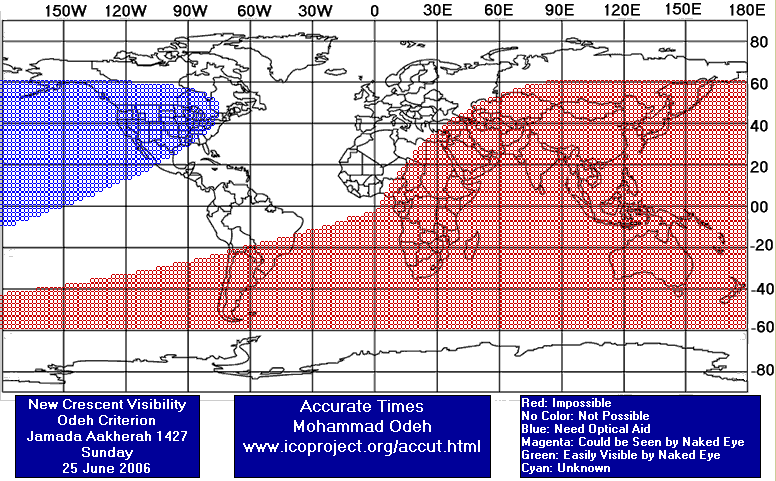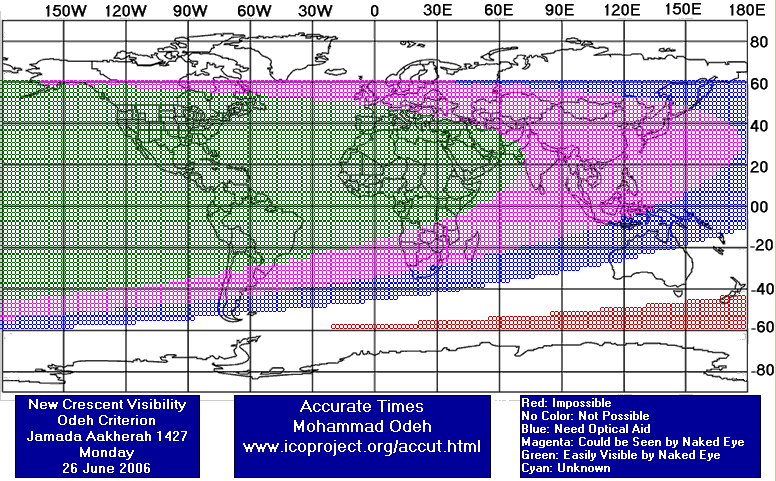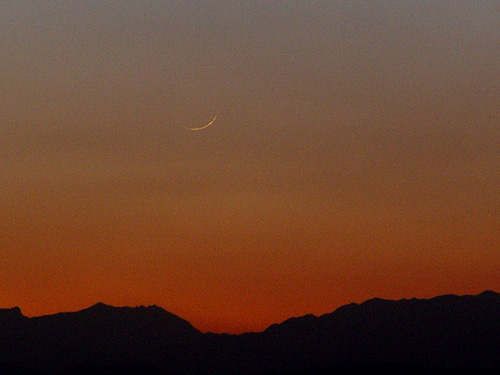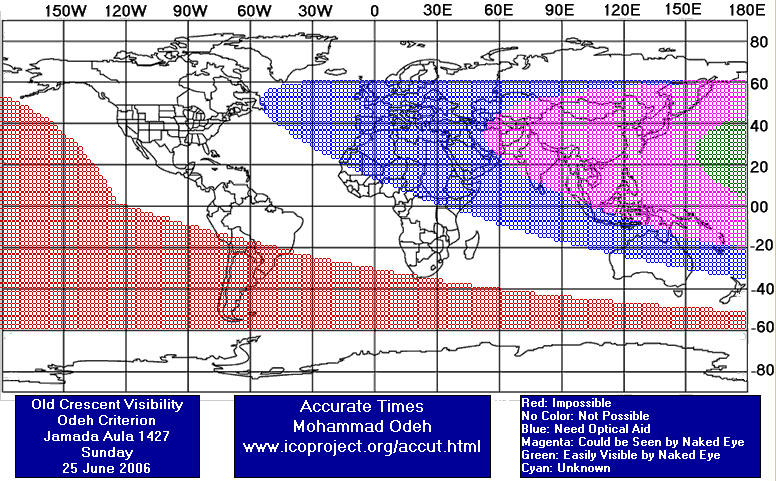Visibility of Jumadal Thani Crescent
(1427 AH)
- When to Observe Jumadal Thani Waxing (NEW) Crescent ?
- Jumadal Thani Waxing (NEW) Crescent Observation Results
- The OFFICIAL First Day in Different Countries
- When to Observe Jumadal Awwal (OLD) Crescent ?
- Jumadal Awwal Waning (OLD) Crescent Observation Results
The geocentric conjunction (Geocentric New Moon) will occur Inshalla on (Sunday 25 June 2006) at
16:05 UT.
Sighting the new crescent on (Sunday 25 June 2006) and (Monday 26 June 2006) is shown in the below graphs using the program Accurate Times by Mohammad Odeh according to Odeh criterion. Where:-
According to the actual sighting of the crescent, the start of Jumadal Thani should be on Monday 26 June 2006 in western parts of the world, while it should start on Tuesday 27 June 2006 in the rest parts of the world.
- Results of seeing the crescent, and the first day of the month in different countries will be added here Inshalla as we receive the reports from ICOP's members. If you wish to be a member in ICOP, or to know more about it, kindly click here.
So far, the earliest sighting of the crescent was on Monday 26 June 2006 by Mohammad Odeh from UAE, the crescent was also seen on that day from Iran, Iraq, Senegal, Germany and USA.
Sunday 25 June 2006:
Monday 26 June 2006:
- Date: Mon June 26, 2006
Monday 26 June 2006:
Tuesday 27 June 2006:
Wednesday 28 June 2006:
The geocentric conjunction (Geocentric New Moon) will occur Inshalla on (Sunday 25 June 2006) at
16:05 UT.
Sighting the OLD crescent on (Sunday 25 June 2006) is shown in the below graph using the program Accurate Times by Mohammad Odeh according to Odeh criterion. Where:-
Sunday 25 June 2006:
When to Observe Jumadal Thani Waxing (NEW) Crescent ?



Jumadal Thani Waxing (NEW) Crescent Observation Results
Finally after three years of successive negative observations I was able
to see a young crescent! Actually this is the first young crescent I've seen
since I left Jordan! In Greece I made several attempts (maybe three or four)
and I was not able to see the crescent in any of those! Either it was partly
cloudy or hazy or I was not look at the correct location of the crescent,
especially that I was using binoculars only! After moving to UAE, I did many
serious attempts! Maybe more than six trails! All of which had failed! And
there is a reason for each! Several of them I reached the location of observation
late! Where I was trying to observe the crescent from Hafit mountain which is more
than 1000m above mean sea-level, and it is about 160 km away from Abu-Dhabi where
I live, specifically in Al-Ain city! Actually I don't like to observe from Abu-Dhabi
near the sea and at the sea-level! Other attempts were failure because the telescope
I borrowed didn't work! I borrowed more than 4 different telescopes, and each has
its own problem! When there is no problem in the telescope it was partly cloudy!
So imagine my feeling after traveling about 90 minutes to see the crescent and
my trial was a failure one! Recently I started to become really nervous after
the negative observation! Thus this time I decided not to travel from my city
and to observe the crescent from where I live! From Abu-Dhabi! And from the
sea-level! Or actually from the sea shore, which is basically the worst location
to observe the crescent from! Also I didn't borrow any telescope! I used my 7X50
binoculars! Surprisingly I DID see the crescent :-)! Actually the sky was
extremely clear compared to the usual atmospheric conditions in Abu-Dhabi!
Usually I used to describe these atmospheric conditions as hazy and not
that favorable when I was in Jordan!! I was able to see the Sun's limb by
naked eyes nearly up to the sunset time, actually at the last few seconds
I had to use the binoculars to trace the Sun! Where it disappeared below the sea
at 19:14:50 (UT+4), the calculated sunset from my location (taking into account
the correct temperature and pressure and the exact coordinates) is 19:50:59! So close!
After that I waited for about 5 minutes and then started searching for the crescent,
until I couldn't believe when I see it at 19:38!! This is the first young crescent
(its age is less than 24 hours) I see after Rajab 1424 AH crescent ( 28-08-2003)!!
I took some photos by my camera, but I think it needs special processing in order
to see the crescent, I'll publish them if I succeed in processing them. I can highly
claim that I saw the crescent by naked eyes, but can't confirm it. My wife was observing
by naked eyes and she also can't confirm whether she saw the crescent or not. Below
are the data of the observation:-
- Day: Monday.
- Date: 26/06/2006.
- Observers: Mohammad Odeh and my wife.
- Visibility: Seen By Odeh by 7X50 Binoculars, 95% by naked eyes.
- Sunset (Seen by Bin): 19:14:50 Beyond the Sea.
- Sunset (Calculated): 19:14:59.
- Longitude 54:21:31 E.
- Latitude 24:32:10 N.
- Elevation 3 m.
- Time Zone: UT+4.
- Temperature (Sunset): 34 C.
- Pressure (Sunset): 997 mb.
- Humidity (Sunset): 56%.
- Seen at 19:38 by binoculars for about 10 minutes.
Crescent data as calculated by Accurate Times at the time of first visibility are:
- Julian Date at Time of Calculations: 2453913.15139
- Sunset: 19:15 LT T. Moon Age: +22H 20M
- Moonset: 20:14 LT Moon Lag Time: +00H 59M
- T. Moon Altitude: +06°:02':56" T. Moon Azimuth: +296°:43':00"
- T. Sun Altitude: -05°:28':57" T. Sun Azimuth: +298°:46':57"
- T. Relative Altitude: +11°:31':53" T. Elongation: +11°:42':51"
- T. Relative Azimuth: -02°:03':58" T. Phase Angle: +168°:15':20"
- T. Crescent Width: +00°:00':19" T. Moon Semi-Diameter: +00°:15':16"
- T. Illumination: 01.05 % G. Horizontal Parallax: +00°:55':56"
- T. Magnitude: -05.15 G. Distance: 392039.05 Km
- Location: Mount Jahanbin - Farsan - Chahar Mahal & Bakhtiyari (32:13.89N 50:39.90E)
- Time Zone: +3.5
- Observer & photographer: Alireza Mehrani
- Sunset: at 19:15 (LT)
- First crescent observatin through 15x80 binoculars: at 19:22 (LT)
- First crescent observatin by naked eyes: at 19:45 (LT)
- Final crescent observatin through 15x80 binoculars: at 20:09 (LT)

Monday 26 June 2006 from Iran

The OFFICIAL First Day in Different Countries

When to Observe Jumadal Awwal Waning (OLD) Crescent ?


Jumadal Awwal Waning (OLD) Crescent Observation Results





